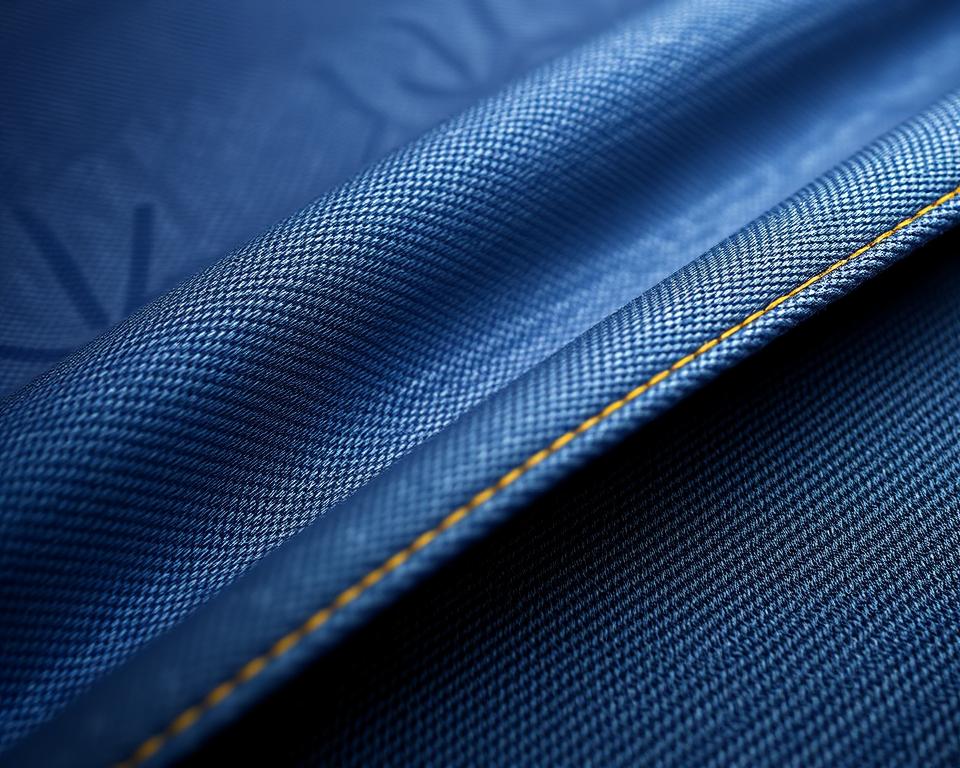Selvedge Denim Beyond Blue: Exploring Other Colors
A Comprehensive Guide to Superior denim Selvedge Material
Ever pondered the reason some trousers seem as though they are designed for longevity a lifetime? Everything revolves around the components and skill. Consider the growing trend of high-end selvedge. This isn’t just any fabric—it attests to quality and heritage.
Nowadays, a growing number of people are turning to these timeless materials for their durability and traditional selvedge denim by the yard allure. Whether you’re a DIY sewist or a denim enthusiast, there’s a unique quality about employing high-quality cotton and stitching. It goes beyond merely constructing jeans; it involves crafting a narrative.
At Core Fabrics, we’ve selected a collection of 14.25oz certified organic cotton and stretch variants. These materials are ideal for all from raw jeans to designer jacket blueprints. Prepared to dive into the realm of exceptional fabrics? Let’s jump right in.
What Is Denim Selvedge Fabric?
What makes particular trousers distinguish themselves with their unique, self-finished seams? The key is found in the selvedge denim, a high-quality material known for its durability and old-school charm. Differing from regular textiles, this fabric is crafted using classic methods that have stood the test of time.
Understanding Selvedge Denim
Selvedge denim is produced with retro shuttle looms, which produce slender widths of about 30-35 inches. They intertwine the material in a method that delivers self-finished borders, often highlighted by a signature red line. Such a process guarantees the fabric is firmly crafted and extremely robust.
Modern looms, in contrast, produce wider fabric but fall short of the equivalent of craftsmanship. Minor flaws in selvedge, like misaligned seams or irregular surfaces, are embraced as part of its charm. This approach, often referred to as “wabi-sabi”, exalts the aesthetic of inherent flaws.
How Selvedge Denim Is Made
The production of selvedge denim entails a meticulous process. Shuttle looms weave the horizontal threads back and forth, resulting in a thick and resilient fabric. Unlike modern methods with contemporary machines, which emphasize quick production and efficiency over durability.
Companies such as Karson Denim maintain vintage Japanese methods from the 1990s. They intentionally include flaws to maintain the true character of the material. Each piece is graded on a 4-point system, ensuring it satisfies the peak requirements of excellence.
| Characteristic | Selvedge Denim | Modern Denim |
|---|---|---|
| Width | 30-35 inches | 60+ inches |
| Construction Technique | Shuttle Loom | Contemporary Loom |
| Surface | Irregular, Flawed | Even |
| Durability | Exceptional | Average |
“The charm of selvedge resides in its natural irregularities—each irregularity speaks of skill and legacy.”
The Legacy of Selvedge Denim
Starting from modest origins to global acclaim, the narrative of these fabrics is vibrant and inspiring. Originally developed as hardwearing clothing in the 17th-century France has become a mark of everlasting fashion and artistry.
Origins in Traditional Weaving
The roots of this textile dates back to Nîmes, France, where it was dubbed “serge de Nîmes.” First intended for the working class, it was constructed with hardwearing cotton and yarn. Its durability rendered it beloved among workers during the Gold Rush.
In the 20th century, it had evolved into a essential element for trousers. The shuttering of the Cone Mills White Oak facility became a pivotal moment. This change enabled Japanese artisans to restore classic fabric-making practices.

Evolution in Modern Denim Production
After World War II, Japan developed a deep appreciation for retro American culture. Skilled workers restored classic looms to manufacture true reproductions. This dedication to artistry guaranteed the continuance of selvedge as a unique product.
Today, innovations from Italy and Turkey have brought forth eco-friendly mixtures and flexible variants. These improvements have widened the attraction of this everlasting fabric. At Core Fabrics, we gather worldwide, from Montréal to Asia, to bring you the finest excellence.
“The history of selvedge is a testament to the lasting worth of quality and tradition.”
Why Choose Selvedge Denim?
What makes selvedge denim distinguish itself in the realm of top-tier fabrics? Its special characteristics and incomparable robustness have made it beloved among aficionados and designers alike. Be it that you are making pants or a structured jacket, this textile offers a fusion of classic methods and updated style.
Characteristic Features of Selvedge
Selvedge denim is celebrated for its tight weave, which boosts durability and fade potential. In contrast to common fabrics, selvedge denim material is produced using traditional shuttle looms, creating a tightly packed and extra robust product. Such a process guarantees that every item possesses a unique texture and personality.
Here’s what makes it special:
- Hairy, rigid raw denim juxtaposes against pre-washed comfort stretches.
- Through sanforization, sizes become reliable, while untreated fabrics provide a unique shrinkage journey.
- Weight options range from 9.5oz Eco Finish to 14.25oz Organic, catering to diverse applications.
Durability and Longevity
One of the most remarkable aspects of selvedge denim is its longevity. The tighter weave not only increases durability but also allows for distinctive color fades over time. This establishes it as a wise purchase for those seeking timeless pieces.
Main considerations:
- Mid-weight fabrics from 12oz to 14oz work well for tailored jackets and evolving jeans.
- For classic jean longevity, the 14.25oz True Indigo is a top recommendation.
- Sustainable variants such as recycled cotton combined with indigo blends enhance eco-friendliness.
At Core Fabrics, our collection includes a variety of options to suit your needs. From raw to sanforized, each piece is crafted to deliver exceptional quality and value.
Selvedge vs. Wide Denim: A Comparison
For making long-lasting and trendy pieces, the decision of fabric plays a crucial role. Two popular options are selvedge and wide denim, each with unique characteristics. Understanding their differences can help you choose the ideal material for your endeavor.
Key Differences in Weaving Techniques
Selvedge denim is woven on time-honored shuttle looms, resulting in narrow widths of 30-35 inches. This herringbone denim material technique forms secure finishes, often accented with a characteristic red line. Conversely, wide denim employs advanced projectile looms, resulting in expansive widths of over 60 inches.
Old-style shuttle looms yield roughly 3m per minute, while projectile looms can produce up to 30 meters per minute. This difference in speed impacts both the price and the finish of the outcome.
Advantages and Disadvantages
Selvedge denim is renowned for its high-end construction and robustness. Its slender dimension renders it perfect for applications where exposed edges or decorative patches are required. However, it can be costlier, typically around $23 per meter.
Wide denim is more cost-effective, typically costing $8 per half-meter. Its expansive dimension minimizes excess, well-suited to extensive endeavors like furniture covering. However, it lacks the unique edge finish of selvedge.
| Feature | Selvedge Denim | Wide Denim |
|---|---|---|
| Width | 30-35 inches | 60+ inches |
| Method | Traditional Shuttle | Projectile Loom |
| Production Speed | 3m/min | 30m/min |
| Cost | $23 per meter | $8/half-meter |
For defined borders as seen in Grainline Thayer jackets, selvedge is favored. In contrast, wide denim provides cost-effectiveness and speedy production. Evaluate your project specifications to choose wisely.
Working with Selvedge Denim
Working with premium materials can elevate your sewing projects to the next level. Be it making pants, blazers, or frocks, grasping fabric quantities, proper sewing methods, and maintenance guarantees a polished result. Let’s explore the optimal use of this timeless fabric.
Fabric Quantities for Your Projects
When planning your project, calculating the right amount of material is crucial. Approximately 3-3.3 yards is necessary for men’s jeans, considering defects and shrinkage. Trucker-style jackets generally demand about 3.3 yards, while skirts can be made with just 2 yards.
Smart pattern positioning minimizes the impact of defects. Rather than avoiding imperfections, incorporate them into your pattern for distinctive style.
| Garment | Yardage Needed |
|---|---|
| Men’s Jeans | 3 to 3.3 yards |
| Trucker Jacket | 3.3 yards |
| Dress | 2 yards |
Tips for Sewing and Care
Employing proper equipment and methods leads to an impeccable finish. Choose #70-110 pins and machine attachments designed for heavy materials. For contrast stitching, Gütermann rPET thread is a reliable choice.
Here are some additional tips:
- Employ a tailor’s clapper to achieve crisp creases without gloss.
- Core Fabrics’ denim kits include topstitch thread, rivets, and 9mm jeans buttons for a professional finish.
- Structured edges, essential for jackets, are best achieved with selvedge.
Maintaining your pieces properly increases their longevity. Limit washing and allow to air dry for optimal durability. Adhering to these practices will sustain your creations for years.
To Conclude
Crafting with premium materials isn’t just about durability—it’s about creating something with character. Selvedge denim embodies this principle, merging artisanal charm with robust strength. From jeans to tailored jackets, every stitch of this material conveys a narrative.
At Core Fabrics, we make it easy to explore your creativity. Try our swatch service to feel the texture and weight before committing. Plus, enjoy free shipping on orders over $150 USD across North America.
Future trends in cotton textiles include sustainable blends and retro washes. These trends offer new ways to add sustainability and style to your wardrobe.
Eager to explore top-tier textiles? Shop now and discover the value of crafting with purpose. Your next project could be a timeless piece that lasts for years to come.

